So the summer is upon us, and for many a miner cooling issues are important. Especially if you have a larger rig or several rigs. This guide is going to breakdown the calculations, configuration, setup and install, and impact measurements to get a micro cooling center running cost effectively for your coin mining rigs. Let’s get started here!

This is going to save you a LOT of energy! My insulated garage door once finished.
Mining Rig Cooling Location and Materials
So there are a few places that you might have your mining rigs setup. A spare room in your house or a garage being some of the ones that pop out at me right off the bat. I have my rig in the the Garage and also live in Austin Tx…so it is really hot during the summer. There are a few items we need to check into before we start doing the calculations for the room that you will be using / converting. If you are in a room on your house with a window that is the best location you can hope for. In a garage we have more challenges…but typically more space and more electrical access…at least I do. If you interested in what my setup looked like prior to the AC install, check it out here >> http://imgur.com/a/5AbSc
So why is location important? Insulation! You need to not be fighting an impossible battle and without certain things in place, you will have a much harder time getting the best bang for your cooling buck. So I mentioned I am in a garage, which of course means I have a garage door also. This is a problem for two reasons. First it is made of Aluminum and heats up very nice when the sun is blazing. Second its a giant freaking door. You have to take into account that its going to try to leak air. Lucky we live in a world of solutions! The garage door itself needs to be insulated and sealed. This is a surprisingly easy task however so fear not! I was panicked when I started doing this all but it only took me couple hours to do alone so I was imagining something much worse then it turned out to be.
Material List
I’m going to assume that you have the basic tools including some utility knife, wrenches and a drill also. The rest of the needed stuff I will outline here. Insulation is itchy, long sleeves are a good idea. Don’t hurt yourself also.
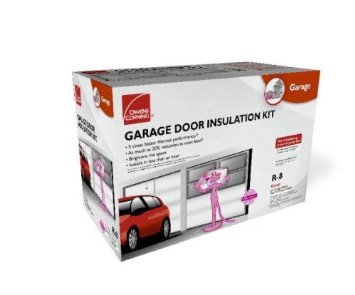
R8 Owens Corning Garage Door Insulation Kit – This single kit will do 9 feet of garage door. If you have a 12 foot garage door, you will need 2. Get out the tape measure and be certain. I did some horribad estimation on the width of mine…turns out I have a 12 foot door. This doesn’t weigh anything installed, makes the garage and house much quieter and cooler also. PLus looks slick when sealed up with the Aluminum duct tape below.
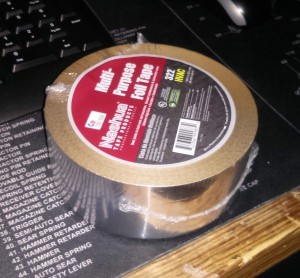
Aluminum Ducting Tape – This is a 50 yard roll which does 1 standard garage door. So if you have a two car garage, you will need to have 2 rolls. 3 car garage? 3 rolls. Very sticky when you are unrolling so don’t let it get stuck to itself. Don’t use grey duct tape, it will not hold. (pic below of failed duct tape attempt)
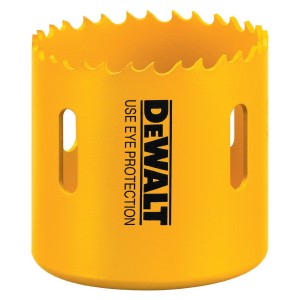 4-1/4″ Wall Drilling Bit thing – This is not something you will ever use again. I’ve been looking all over my house for other things that need a big ass hole in them. So far, nada.
4-1/4″ Wall Drilling Bit thing – This is not something you will ever use again. I’ve been looking all over my house for other things that need a big ass hole in them. So far, nada.
 Drilling bit adapter thing – Same story as the hole drill thing. No other uses for this I can see but needed for drilling these holes. If anyone else has any fun ideas, let me know. I’m thinking of adding some extra bathroom vents….
Drilling bit adapter thing – Same story as the hole drill thing. No other uses for this I can see but needed for drilling these holes. If anyone else has any fun ideas, let me know. I’m thinking of adding some extra bathroom vents….
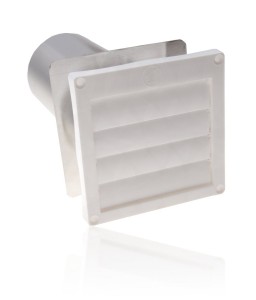 2x 4″ Exhaust vents – These have backdraft louvers on them. The Intake vents louvers must be removed no matter what, or they will prevent suction. The exhaust I guess you could leave on if you wanted. I removed um both on mine as I installed the vent covers on both.
2x 4″ Exhaust vents – These have backdraft louvers on them. The Intake vents louvers must be removed no matter what, or they will prevent suction. The exhaust I guess you could leave on if you wanted. I removed um both on mine as I installed the vent covers on both.
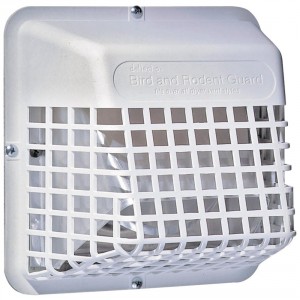 2x Exhaust vent covers – Vent animal and thing guard. This should hopefully keep the animals at bay! I also spray insect killer poison around the vents (with the A/C turned off. learned that the hard way!) to keep crawlers out.
2x Exhaust vent covers – Vent animal and thing guard. This should hopefully keep the animals at bay! I also spray insect killer poison around the vents (with the A/C turned off. learned that the hard way!) to keep crawlers out.
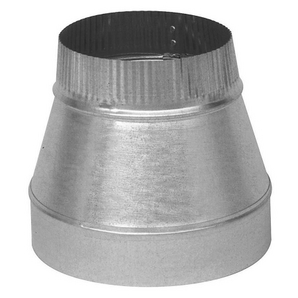 2x 5″ to 4″ reducers – I am so glad that they make something for about any item that does everything. This is the “coupler” in effect and you will need to do a good job on the tape (aluminum tape only here) that seals this to the exhaust and tubes. Don’t worry, pics below!
2x 5″ to 4″ reducers – I am so glad that they make something for about any item that does everything. This is the “coupler” in effect and you will need to do a good job on the tape (aluminum tape only here) that seals this to the exhaust and tubes. Don’t worry, pics below!
An A/C unit (details after we size the appropriate unit) See Below
Cooling Calculations
So essentially you have a server room level of heat that will be generating in your garage or room space if you have a lot of rigs. Lot of rigs = lot of heat. Every Watt of power that these cards draw, they create a watt of heat. 1 watt of heat = 3.412 BTU of heat. So we are going to add up everything that is running to get a total number of BTU here.
Rig Equipment: So there are 2 ways to calculate the rig equipment. Accurate would be to look at every component, but probably safer to assume you are maxing that PSU. So take the total wattage of the PSU * the total number of PSU’s.
I have (4 * 850) + (1 * 550) = 3950 watts running 24/7 between home media server, workbench computer and rigs
So when I look now at that from a BTU rate, that is 3950 * 3.412 = 13477 BTU’s. We need to have this number on hand when we evaluate cooling options below. In looking at it, I need a 14K btu unit. Lucky me! I have a great unit from my offices old server room that is a 14K unit. Since we moved our systems to the cloud, it is not needed there and was just sitting in my office staring at me…along with a pile of servers. Glad to move some of that clutter out at least.
You can also visit my site >> http://makearig.com/ and select you cards, # of cards per rig and # of rigs. Then click the “add to rig” to see a total BTU for a given config. Nifty.
Picking out that A/C Unit
If you are in a garage without a window, then a portable A/C unit is going to be your best option. Also if you have a HOA that may move you to chose this also. If you are in an interior room in a house, then you will use a portable A/C also. (exhaust to attic) Im doing the install guide based off my system and installation. Also you must use a dual hose portable, the single ones are worthless.
Portable Units

EdgeStar Server Room 14,000 BTU Portable Air Conditioner – This is the same model that I have, but newer by a 2 years. I asked this company for some coupons (they are Austin based also) and they gave me a $50 off coupon for this – MAKEARIG – sweet! Living Direct is down the road from my office and happy to give me coupons it seems.
Mine doesn’t have the cool looking remote but the rest of the specs look the same and the shape looks about the same also. You can checkout mine below in the install guide, the hose kits look identical and are both 5″ sized.
Window Units
If you have a window you can use a window A/C unit. They dont require you to drill huge holes in walls. However they are tacky a bit and not easy to move around. I’m not going to go into the install advice for a window A/C unit. It should have adequate directions included. I got those guys to give me a 5% off coupon on anything else MAKEARIG5 so you should be able to use it for one. I also asked for advice on the good Window units and got the following reply:
For WACs I would recommend Friedrich’s Kuhl line. They’re able to be connected wifi with the optional kit and able to be operated through an iphone/ipad app. I’d imagine feedback from the unit would be crucial in a server application. (BTW the wifi adapter isn’t live yet, will be coming next week)
Models:
Model – SM24N30A
– Huge unit if you need to cool over 9000 Watts of cards. Note that’s 230 VAC. Has a wifi app? Cool.
Model – SS12N10B (Standard Plug)
– 120 standard plug for smaller racks. Still has the wifi remote monitor app however.
While a wifi app is cool and all, Budget is cool also. After all its A/C we are after here.
This Frigidaire 12000 BTU Window AC is a great price for 12000 BTU @ 349 minus 5% extra
Mini-Split Systems
If you are a badass with a bunch of rigs or have a lot of money to blow, use a split system. They are awesome, costly and need some good install help. I’m not going to go into the install advice for a split system, as I have no idea. They do cool large open areas very nice from what I have seen in the city with some friends who have townhomes. They gave me a recommendation for 12K – 36K BTU systems as follows:
Model:AMS120HR – 12K BTU’s
Model:PMS241HX – 24K BTU’s
Model:PMS361HX – 36K BTU’s
Setup and Install
So we have two things that we need to address here to get up and running. Insulation and installing the A/C unit. I’ll start with installing the A/C unit first here as it important to get done ASAP before it heats up too much. Again long sleeves, early morning, and an extra set of hands if you can find um will be helpful. I did it myself as I live pretty far away from most my friends who would help out with a job like this. Wife was minimally helpful at best but did tell me it looked nice… yay. Insulation of the garage door was 2 and a half hours. I have a single car garage so I think you may be looking at 4 hours on your own installing for a 2 car garage. Also I insulated the attic of the garage, since it didnt have any in it. Unbacked insulation for that to prevent mildew. Lucky we have good attic vents. I live in Southwest Austin for reference also, it’s HOT here in the summer but has been rather cool so far this year!
Insulation of the garage door should follow the few steps here:
- Clean off any existing dust on the garage door support braces and hanger mount locations in the middle of each pane. This is good to do with alcohol water spray. It is dirty trust me and will give you issues with taping later. DO NOT USE DUCT TAPE! IT WILL DO THIS CRAP!
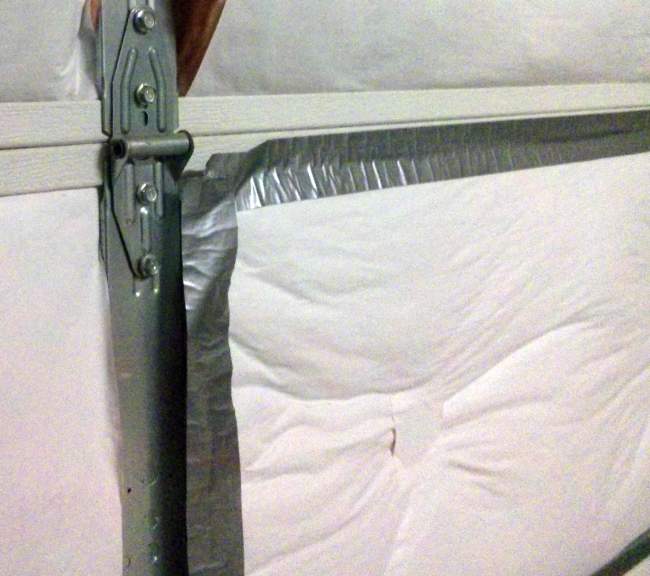
I guess I found the first thing that duct tape doesnt work for.
- Cut the insulation pieces. This goes fast if you do it like a assembly line and cut all the lengths first.
- Stick the hangers on. It goes fast.
- Hang the insulation pieces. Cut a small slit in the middle for each hanger to poke through.
- Grab that aluminum tape and start taping the sides. You may even get OCD and remove some hardware to get a ultra pro looking install. Its okay, I wont judge 😉
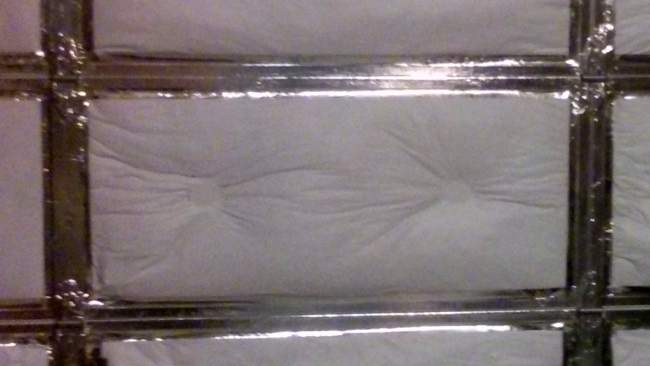
Make it look good 😉
- Relax for a bit. Good job! If you are insulating the attic, I feel that pain. Best luck to you.
- Insulate attic (if needed) Don’t skip this cause you get lazy. It does suck. It will make a huge difference however. With my attic and garage door insulated I have needed to run the A/C unit only if it gets to ~84 outside. It would be very hot without them both insulated. If you have a window, foil it over and saran wrap insulate it. Careful to not fall through the ceiling and watch out for electrical wires and roof nails! Insulation goes UNDER wires or slit a path. Never insulate over wires. Don’t jam the insulation up to the edges. You need to leave the soffits clear with a clear path for air to get drawn in on all edges. Also make sure you have a good nice seal on the attic door so that you are as close to airtight as possible. A/C will push and pull into seems and cracks.
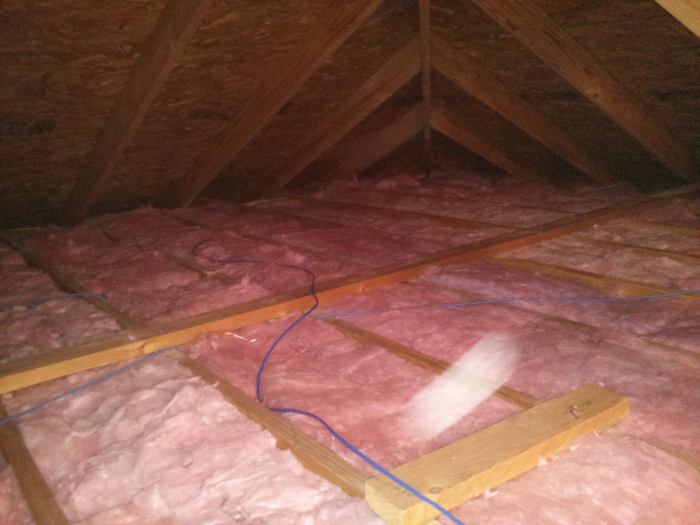
Insulating the attic is a very itchy job. However my garage now feels as insulated as the rest of my house. Plus it is quiet.
- Okay attic insulation will take a long time. It will suck. I hope it is over. Grab some water. Wanna get super energy efficient? I’m talking attic fan! I installed one last year and our indoor A/C doesn’t kickon until it gets over 88 outside.
- Garage door seal. If you have a new-ish house this should be pretty tight already. Mine already has rubber seals installed so the garage door seals up nice. If not go ahead and do that also now.
- Check for other air leak areas. Got oddball drilled holes for some reason? (like electrical installs…) Caulk that up. Windows? Check those for leakiness and caulk.
Install the A/C unit (portable A/C unit)
Okay so you have the portable A/C unit present and now are ready to install that bad boy! Find a place that is in a good position for the A/C unit to plug into a circuit that you dont have unprotected electronics running on already. Actually plug it in and move the unit around so you can get a good placement of the unit. It needs to have space around it. Dont smush it’s back directly into the wall. I’d say 2 foot minimum is needed.
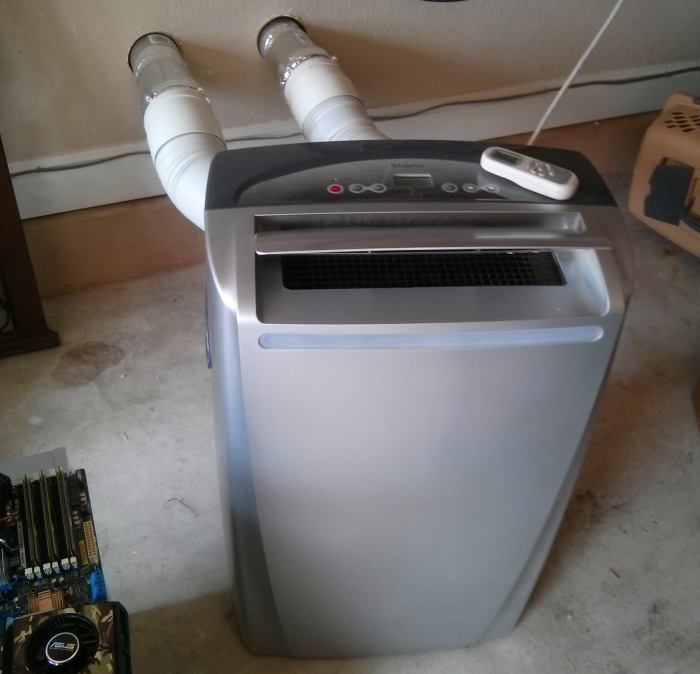
Make sure you have the unit pointed correctly and spaced out a bit. Here it is installed.
- Now that you have the placement of the unit, go ahead and get out the hoses for the unit (double hoses) and install them onto the back of the unit. Make sure that you have no crazy bends in them as you stretch them to their eventual placement on the wall. Mark the spot for both the output and input vents. POINT THE AC TOWARD YOUR RIGS!
- Check for a stud in the middle of the area you marked. That will give you a big problem if you accidentally drill into it. Plus extra holes in a house = bad. Okay so you should also space the placements out so that they have 1 stud in between them. You don’t wanna suck in your exhaust vents heat.
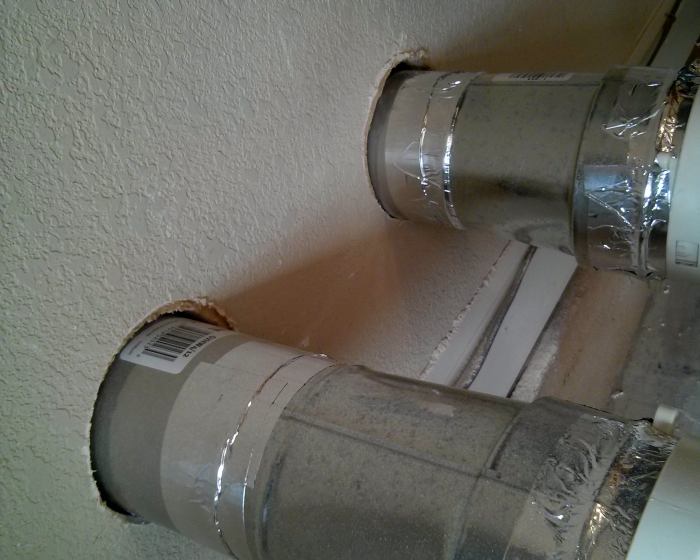
Dont screw this up. You dont want lots of holes in the wall.
- Get out the hole drill and shank. Attach to your drill. Drill. Do it from the inside to the outside. This will prevent something bad from happening. Trust me. Once you have the tip of the shank drilled past the exterior of your house’s exterior material, then you can go outside and drill inside with perfect precision thanks to that hole.
- Grab up the Louvered exhaust vents. Remove the backdraft louvers from the intake one at a minimum. I removed them from them both and installed 2 bird guards. They will bend a bit to let you pop them out.
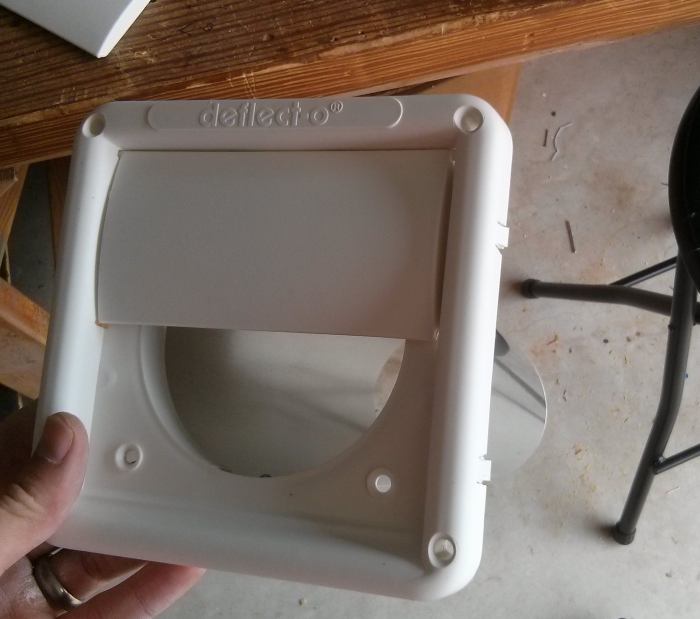
You can bend and remove the backdraft lovers pretty easy from these.
- Install them from the outside to the inside.
- Fasten them into place. Now head back inside.
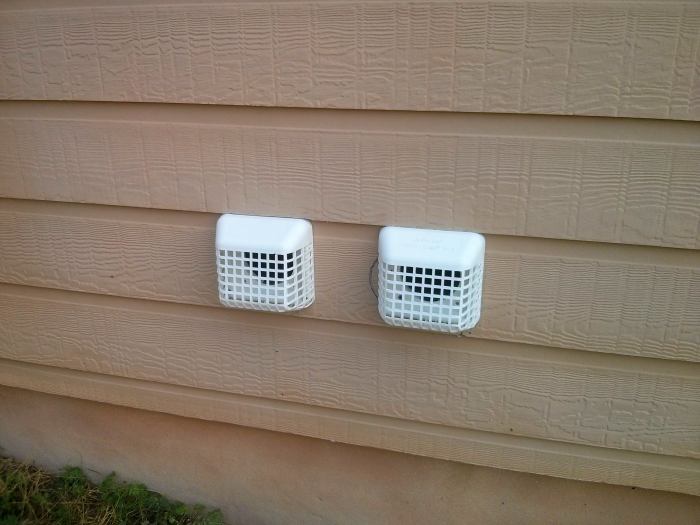
Hey that looks pretty good after all!
- You will need to tape up the 5″ to 4″ reducers now to the exhaust hose and intake hose from the unit. Use the Aluminum tape here also. Do a very good job taping those.
- Now “mate” the reducer to the wall exhaust. I was able to jam mine into it a bit and then tape over them to hold it in place very snuggly.
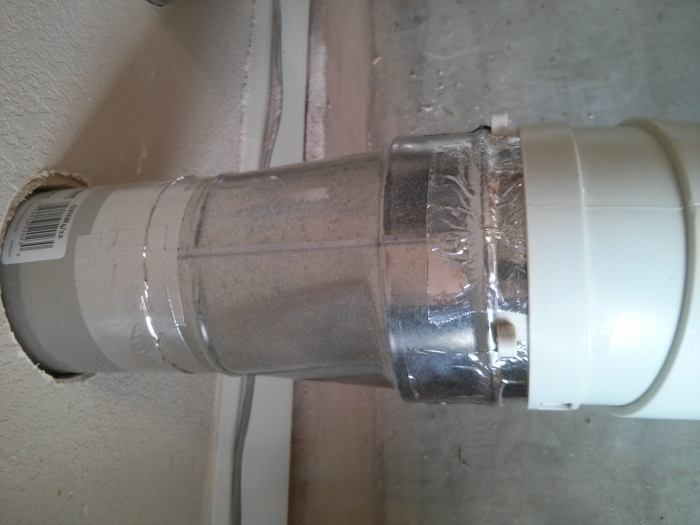
Do a good job with the tape here. Finally its looking done!
- Follow the rest of the checklist items for first turnon. You shouldn’t need to worry here about a drain line, as this will automatically exhaust the evaporate with the heat. (another reason not to have any crazy kinks in that exhaust line run)
- Set it to auto cool and a temp around the 80’s to kick in the A/C cooling. My model runs the fan constantly regardless of if its cooling or not, but does so at very low wattage draw.
- I am now ready to have nature bring on those 100+ days!
Other Thoughts
I now actually put a nice chair out in the garage and am in the processes of “caving” it out a bit. It is crazy all this is running and so quietly! Plus since its humidity controlled now I’m storing my telescope stuff in the garage. More room in the house as a result 🙂 I installed a dartboard and have IPTV in there. Now I need a small Keg and I’ll be set!

The garage is now comfy and becoming a man-cave also.

Recent Comments